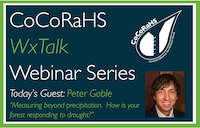|
Webinar #90 - September 2024
Measuring beyond precipitation. How is your forest responding to drought? Peter Goble
Colorado Climate Center
Colorado State Univ.
Fort Collins, CO 
Biography
The US Drought Monitor (USDM) is a critical tool used to assess drought conditions and plan drought responses. However, data collection and monitoring can be challenging, especially in remote locations. Reports in forested areas, both empirical and anecdotal, are often sparse. Consequentially, forest conditions are underrepresented in the US Drought Monitor process, and quality of drought appraisal suffers. Resource managers and professionals working in forested landscapes are often acutely aware of current conditions and are frequently the first to observe drought-related changes in forest/vegetation health, soil moisture, streamflows, and patterns of human use.
Peter has worked with the US Forest Service to increase CoCoRaHS Condition Monitoring in forested areas across Colorado. Targeted outreach raised the number of Colorado CoCoRaHS Condition Monitoring reports collected in the months of May-September from 346 in 2021 to 610 in 2022. These additional reports were used in the US Drought Monitor Process to observe progress in forestland health as drought conditions ameliorated during the 2022 monsoon season. Additional Condition Monitoring reports were particularly helpful on the San Juan National Forest. May-September participation increased from 3 to 39 reports in Archuleta County and from 16 to 52 reports in La Plata County.
In this webinar Peter talks about what we have learned from these additional Condition Monitoring Reports in forested areas so far, and plans to continue to fill the drought impact data gap in forested areas.

View the Webinar by clicking here
View Peter's presentation slides here 
Resources:
|